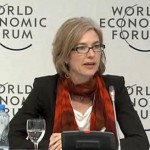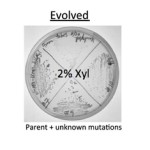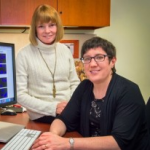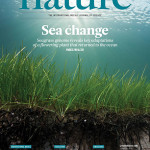Susan Celniker, Senior Scientist and Deputy Director of the Environmental Genomics & Systems Biology Division, has been honored as the recipient of the 2016 George W. Beadle Award for her outstanding contributions to the Drosophila community, in both research and service. This award was established by the Genetics Society of America (GSA) in 1999 to honor Beadle (1903–1989) who served as the President of GSA in 1946 and was a respected academic, administrator, and public servant. Celniker will be presented with this award at The Allied Genetics Conference (TAGC), July 13–17, 2016, in Orlando, Florida. Read more on GSA’s blog, Genes to Genomes.
Biosciences Area Scientists Participate in World Economic Forum
Faculty biochemist Jennifer Doudna and Biosciences Area Associate Laboratory Director Jay Keasling attended the World Economic Forum in Davos, Switzerland, last week, to bring their unique perspectives to world leaders. Both researchers were named to Al Aribya’s “45 top scientists at Davos you should know about” list.
Breaking the Xylose Bottleneck
Xylose utilization remains the primary bottleneck in fully using the renewable plant biomass. In a Nature Scientific Reports paper entitled, “Evolved hexose transporter enhances xylose uptake and glucose/xylose co-utilization in Saccharomyces cerevisiae,” Biological Systems & Engineering Division researchers at Joint BioEnergy Institute (JBEI) Amanda Reider Apel and Aindrila Mukhopadhyay report the discovery and characterization of a yeast sugar transporter variant with superior Vmax (uptake rates) for xylose. This discovery will be valuable in developing biomanufacturing strains that can use the full set of sugars generated from plant biomass. Read more on the JBEI website.
Scientists Discover Protein’s Starring Role in Genome Stability, and Possibly Cancer Prevention
If you have a soft spot for unsung heroes, you’ll love a DNA repair protein called XPG. Berkeley Lab scientists discovered that XPG plays a previously unknown and critical role helping to maintain genome stability in human cells. Their findings also raise the possibility that the protein helps prevent breast, ovarian, and other cancers associated with defective BRCA genes.
The work, which is published online January 28 in the journal Molecular Cell, indicates XPG is essential to our health in ways far beyond it’s been given credit for.
Priscilla Cooper of the Biological Systems and Engineering Division conducted the research with Kelly Trego and several others at Berkeley Lab, as well as scientists from Colorado State University, Yale University, and Erasmus University Medical Center in the Netherlands. Read more at the Berkeley Lab News Center.
First Marine Angiosperm Genome Sequence
Coastal seagrass ecosystems cover some 200,000 square kilometers. They account for an estimated 15 percent of carbon fixed in global ocean, and also impact sulfur and nitrogen cycles.As a foundational species in the coastal marine ecosystem, researchers are interested in understanding how the plant—and by extension other plants in the ecosystem—adapts to climate change. Published online January 27, 2016 in Nature – and as the cover of the journal’s February 18, 2016 issue – a European team including researchers from the DOE Joint Genome Institute (DOE JGI) sequenced a seagrass genome: that of the eelgrass Zostera marina, taken from the Archipelago Sea off Finland. Read more on the JGI website.
- « Previous Page
- 1
- …
- 197
- 198
- 199
- 200
- 201
- …
- 213
- Next Page »
Was this page useful?








